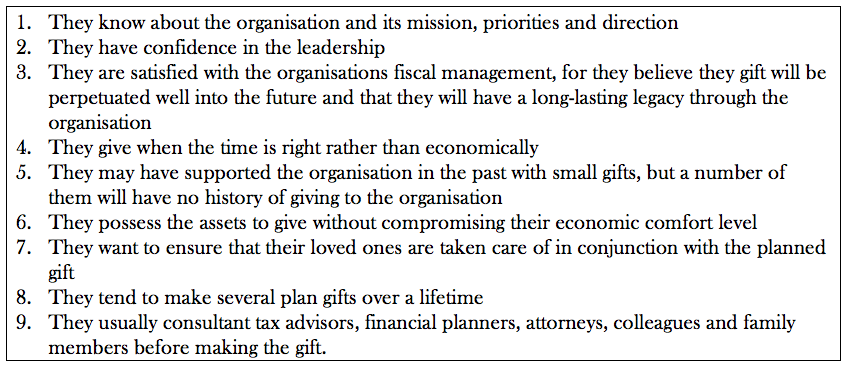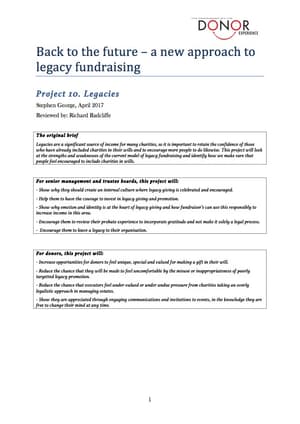CDE project 10 section 4 part 3: how the donor might behave and how can we use insight to improve experience
- Written by
- The Commission on the Donor Experience
- Added
- April 25, 2017
It would be wrong not to be absolutely explicit about the role and understanding of emotions in legacy fundraising. The emotional connection when considering a gift, as we have described, is powerful when thinking of a legacy. David Love, the Canadian Godfather of Good, (WWF and Agents for Good), who has championed donor-led legacy fundraising for 50 years, describes the ‘the story of yourself’ in a legacy.
Much has been written about the power of emotion, and this will be a thunderous roar through most of the project papers in the Commission on the Donor experience for many. As a reference to draw these together, and at the heart of thinking about how these can be used in legacy fundraising, the following are links to four resources pertaining to the art and science of emotion.
1. The emotional brain – Effective fundraising it seems is all in the mind - Ken Burnett
2. The use and misuse of fundraising- Dr Kiki Koutmeridou
3. Adventures in emotional space – Fundraising is inevitably emotional but are fundraisers? - Ken Burnett
4. The positives and negatives of emotional fundraising- Jenny-Ann Dexter
In Ask – How to ask anyone for any amount for any purpose, Laura Fredricks has identified the following characteristics of donors who leave a legacy.

These help to attain an insight into the donor who is making a planned gift – a legacy. In their 2003 AFP report Identification, Death and Bequest Giving, Adrian Sargent and Jen Shang identified that donors have five motivations for giving a gift (not in order of priority):
- Family need
- Tax
- Need to live on
- Spite
- Making a difference
Some aspects may seem obvious, but it is worth reminding ourselves that simple things done well can often outperform new and innovative things. We all know that stories are critical to engaging and inspiring donors emotionally. In terms of legacies, this is vital. As an illustration, in 2014, Russell James, professor at the Department of Personal Financial Planning at Texas Tech University conducted a study to uncover the right legacy messages; he found that:
‘Using living donor stories outperformed all other messages for 40 of the 40 charities (studied)’ – Russell James.
If we combat the barriers that prevent the understanding of the needs and behaviour, we can make great strides in creating a better experience. In the section on organisation and marketing, we will explore donor insight further.
Therefore, through the exploration of best practice, fundraisers, insight and some donors’ feedback, the following principles and actions should be promoted to improve the donor experience and to give legacy fundraisers the best opportunity to meet and exceed donors’ needs.
1. Fundraising staff, volunteers and partners should begin with insight into and understanding of donors via data, evidence, and behaviour and - most of all – by asking and listening to what donors say they want and need.
- Donor experience can be learnt, understood and replicated. Obtaining insight requires a deliberate process and mind-set of learning
- Experience and engagement can be enhanced significantly by seeking the input, opinions and views of donors
- Donors value being asked - value is translated into a closer relationship.
2. Amplify personal insight, knowledge and behaviour so that donors feel unique, special and valued
- Legacy fundraising has long implemented a model in which face-to-face visits are encouraged. However, as time passes and the emphasis is on engaging a wider audience, the nature of the gift, the complications and the special nature thereof demonstrate a quest to retain and enhance a personal relationship
- Legacy fundraisers show a high awareness of the need to drive personal communications; this needs to form the backbone of contact whenever possible
- The deliberate recording of age, name, background story, birthday and any other insight helps build personal interactions
- Many Legacy Fundraisers send hand-written and bespoke communications and invest in staff structures that enable this.
3. Use stories as the way to communicate, inspire and engage
- We know that donors feel their experience is closer and more emotionally engaging when they hear of or are part of a story
- However, Legacy Fundraisers have struggled to make the most of this. A culture of storytelling helps to generate stories and to engage donors by asking key questions such as ‘How did you first get involved?’ Why did you first start to support us?’ ‘Tell us your story’
- Creating a deliberate story collection process encourages the collection and sharing of stories
- Sharing stories frequently helps to motivate and inspire. All channels can and should carry stories.
4. Demonstrate the current impact and outcomes of the charity and about its cause, as this reinforces confidence when donors consider the future impact of a gift in their wills.
- Anxiety about how gifts will be used in the future needs reassurance in terms of clarity concerning how gifts are spent at present
- To support future confidence, showing the impact that current gifts in wills are making is critical
- Using examples of recent and existing gifts to deliver a service or programme reassures and inspires those considering a gift.
5. Building on existing connections or offering to connect with the work motivates and inspires gifts and reinforces relationships
- Events should be focused on the work and the impact thereof more than on the mechanism of a legacy. In previous years, the events were legacy events. Current practice focuses on an event that is about the work with a legacy element included and stated openly.
- Finding ways to connect the donor to the cause and the work builds trust and deepens relationships
- Invitations to events are ways to increase contact and inspiration even when donors can’t or don't attend. The act of inviting has great value and must be part of the measures of success.
6. Embrace the heritage of the organisation and the charity’s founding and journey up to the present, however recent. This enhances the experience and value of a legacy gift and demonstrates organisational and donor trust and stewardship from the past, in the present and into the future.
- Past personal experience and memories are key elements when looking at the heritage of a life or of an organisation. Reflect on messages that look to the past and the creation of the charity, at present and into a positive, optimistic future.
- Finding founder stories help reinforce passion and longevity. Messages and materials should reflect this combination.
7. Thank donors who are considering making a bequest as much as those making a commitment –taking a step towards considering a legacy is a major one, and every step requires encouragement, gratitude and support.
- Move thanking the donor up the scale to acknowledge each step
- Legacies are a long term consideration and require the experience and journey to be positive and help spur a next step
8. Build and deliver consistent messages. Communications that conflict with legacy messages undermine the legacy journey and the donor experience. If donors feel they are not valued or part of the solution, they will withdraw.
- Create an organisational legacy messaging or brand book
- Use core language, phrases and words
- Require all communications with legacy messages to follow these guidelines, regardless of the channel and the audience, in order to create consistency
9. Focus on long-term results through short-term activity. Donors and fundraisers need to understand the balance between these aspects because they are investing for the long term rather than to attain a short-term hit, even though the need may be urgent
- Future value can be stored and measured
- Long-term intent and aspiration are key parts of positioning for charities
- Short-term campaigns are about building a pipeline for the future
10. Inject emotion into wider messages. Emotion drives donor satisfaction and is the key building block to inspire supporters to give
- Understanding how to connect with emotion should be a core skill of all fundraisers, particularly those delivering legacy programmes
- The wider supporting teams should be able to use the legacy messaging and ‘brand book’ to guide and support emotional content
11. The organisation’s style, approach and culture should do all it can to match the donor experience and messages as a core competence
- Staff should receive an induction and training about legacies and the donors’ experiences and needs
- Donor insight, understanding and motivations should be a core competency
12. Ensure donors receive feedback and dialogue to deepen trust and relationships


















